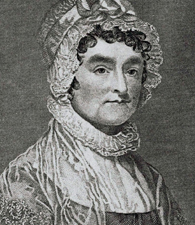First Lady Abigail Adams became the first presidential wife to live in the White House when she joined her husband, John Adams, in Washington in 1800.
Abigail Adams’ Early Days
Abigail Smith was born in Weymouth, Massachusetts on November 11, 1744. Her father, William Smith, was a minister, and her mother was Elizabeth Quincy, a member of the prestigious Quincy family. Adams was home-schooled in reading and writing, and took advantage of her father’s large library to advance her studies. Her poor health isolated her as a child, so most of her teenage years were spent studying. Abigail met John Adams at a family wedding; the two were married on October 25, 1764. They initially moved into a house in Braintree (now Quincy), Massachusetts, but the family resettled in Boston four years later, where Adams led an active social life among the city’s powerful families. Throughout the early years of her marriage, Adams was at home, managing the house and raising her three sons and two daughters. Meanwhile, John Adams was spending most of his time in Philadelphia at the First Continental Congress. Throughout the American Revolution, the couple corresponded regularly by letter. Adams gave her husband valuable insight into public reaction to the Revolution.
Sources in this Story
- National First Ladies’ Library: First Lady Biography: Abigail Adams
- The White House: Past First Ladies: Abigail Smith Adams
- PBS: John & Abigail Adams: Abigail Adams
- FindingDulcinea: Three Sides of John Adams
Adams’ Notable Accomplishments
After the Declaration of Independence was ratified, John Adams left for Europe as a diplomat representing the United States. Abigail Adams continued writing frequent letters to her husband, keeping him updated on the political developments in the United States. After five years apart, she finally reunited with her husband in Paris in 1784. Adams moved with her husband to England, where she stood by his side as he served as the first United States Minister to Great Britain. In 1788, the Adamses returned to Massachusetts.
When John Adams became Vice President under George Washington in 1789, Abigail Adams moved her family to New York City to be with her husband. The government relocated to Philadelphia the following year, and Adams followed her husband, although her poor health forced her to spend most of her time at their Massachusetts home. Adams became close friends with Mrs. Washington and used her social prowess to entertain important guests. In 1797, John Adams was elected the second president of the United States. When the capital was moved to Washington, D.C. in 1800, Abigail Adams once again moved her family. As First Lady, she served her husband as public hostess and private counselor. She supported her husband in his conservative and strictly Federalist political policies. Adams also argued for the emancipation of slaves and for equal education for women, but was not successful in achieving these aims.
The Woman and her Work
- “Dearest Friend: A Life of Abigail Adams” by Lynne Withey
- “Portia: The World of Abigail Adams” by Edith B. Gelles
- “My Dearest Friend: Letters of Abigail and John Adams” edited by Margaret A. Hogan and C. James Taylor
- “The Letters of John and Abigail Adams” edited by Frank Shuffelton
- “PBS American Experience: John and Abigail Adams” (DVD)
The Rest of the Story
The year 1801 marked the end of Abigail Adams’s tenure as First Lady. The failure of her husband’s reelection campaign and the death of her son Charles made for a bitter beginning to the 19th century for the family. The couple returned to their home in Quincy, Massachusetts, and spent the next 17 years together. On October 28, 1818, Abigail died of typhoid fever at the age of 73. Her family’s political legacy continued with her son, John Quincy Adams, who became the sixth president of the United States in 1825.
HBO adapted David McCullough’s Pulitzer prize-winning book “John Adams” into a miniseries in early 2008. Laura Linney won an Emmy for Outstanding Lead Actress in a Miniseries or Movie for her portrayal of Abigail Adams.
This article was originally written by Caleb March; it was updated November 14, 2017.











